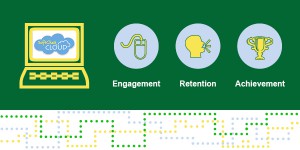
The gamification market is expected to have an estimated growth rate of 67.1% from 2013 to 2018. According to Merriam-Webster’s online dictionary, “gamification is the process of adding games or game-like elements to something (as a task) so as to encourage participation.” Gamification is especially making waves in the K-12 eLearning. A study found that 74% of the 694 K-8 teachers surveyed use digital games in their classrooms; many of them weekly
So why is the gamification industry becoming such a high demand in eLearning?
One of the essential answers is the chain reaction gamification provokes in the brain.
Games create excitement within the brain of the learner
The hormone endorphins are released in the brain when people’s minds and bodies are stimulated through activities such as exercising — this effect can also be achieved by playing e-learning games. Endorphins are a hormone that creates a feeling of happiness and prosperity. The feeling of happiness achieved while learning boosts engagement and motivation within the student to complete the game.
Games help students retain more information
Endorphins are neurotransmitters, which means that they have the ability to send signals to other neurons. This means when these hormones are released, students are not only having more fun within the activity, but are also absorbing more information. The immediate feedback given to students in games lets students determine what they need to do differently in order to progress in the game on their own. This too allow students to internalize the lesson.
Through gamification, information is being learned rather than being memorized.
The learning experience is more impactful; therefore, more memorable
Students are allowed to take control of the learning process privately. They are permitted to practice skills they feel uncertain about as many times as they need in order to retain the information enough to progress in the game. Not only does this make that the learning experience more individualized, but also creates a feeling of accomplishment within the student.
The sense of excitement that is generated when students feel triumph when completing the games leads to a domino effect. The excitement the student undergoes causes a boost in motivation which causes the learning experience to be more unforgettable and compelling.
ELearning softwares such as SoftChalk seem to be on to something greater than just making learning more enticing to students. SoftChalk Cloud offers over 20 different learning activities and games including: Crossword Puzzles, DragNDrops, Jigsaw Puzzles, Ordering activities, Seek A Word activities, Sorting activities and more. All learning activities are even designed to be compatible with mobile devices.
Gamification is revolutionizing the methods and the level at which students retain as well as learn information is various subjects. Additionally, the predicted growth rate illustrates that other industries including eLearning have come to see the benefits of gamification benefits as well.

2 Comments
George Brooks
I am looking for a puzzle creator for my Canvas Website, is there one in SoftChalk.
Natalie
Hi George,
We do have a Jigsaw Puzzle activity within SoftChalk Create that you can use for your lessons. It ranges from a 4 piece puzzle up to 100 pieces. I hope this helps!
Best,
Natalie S.